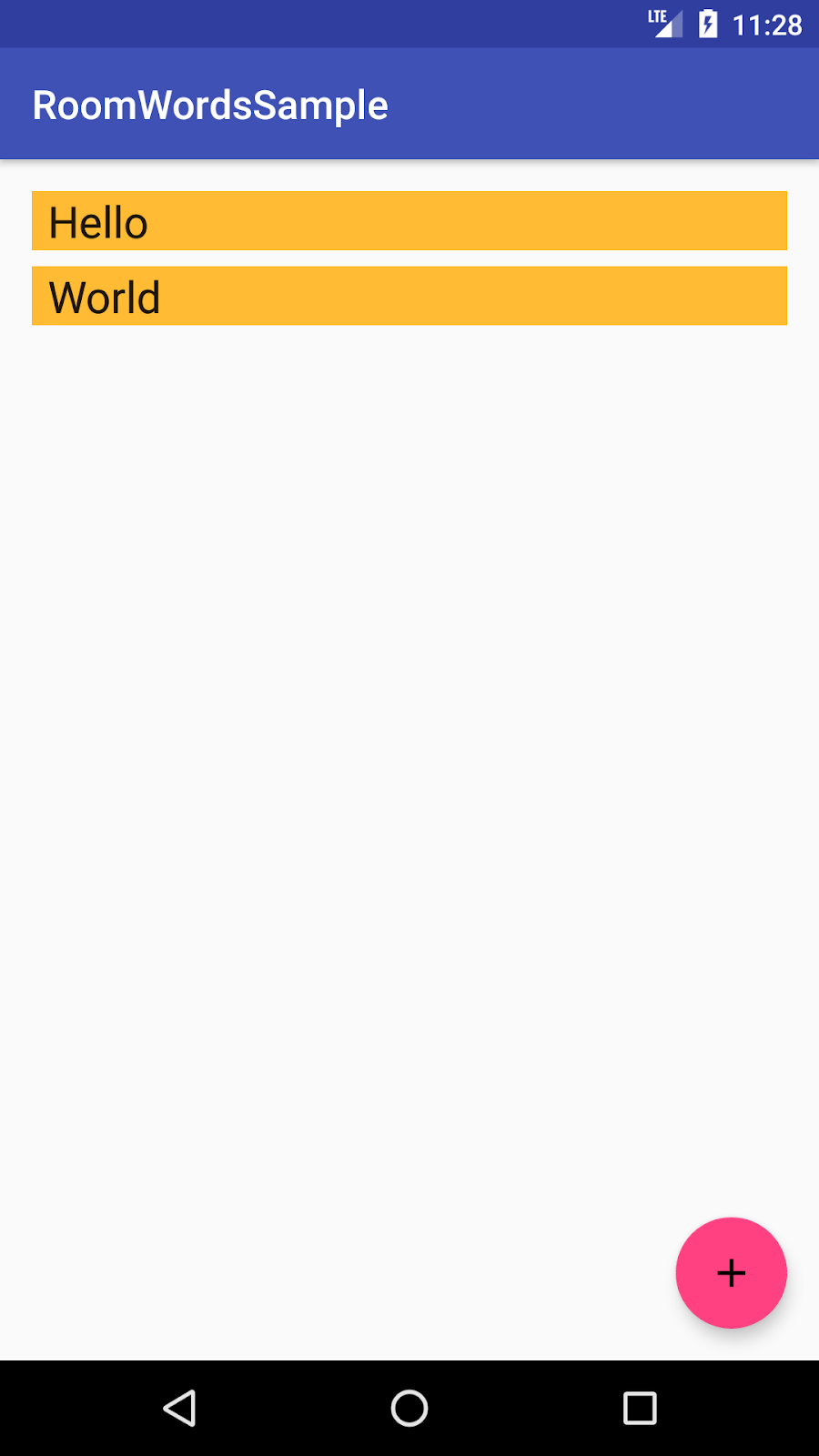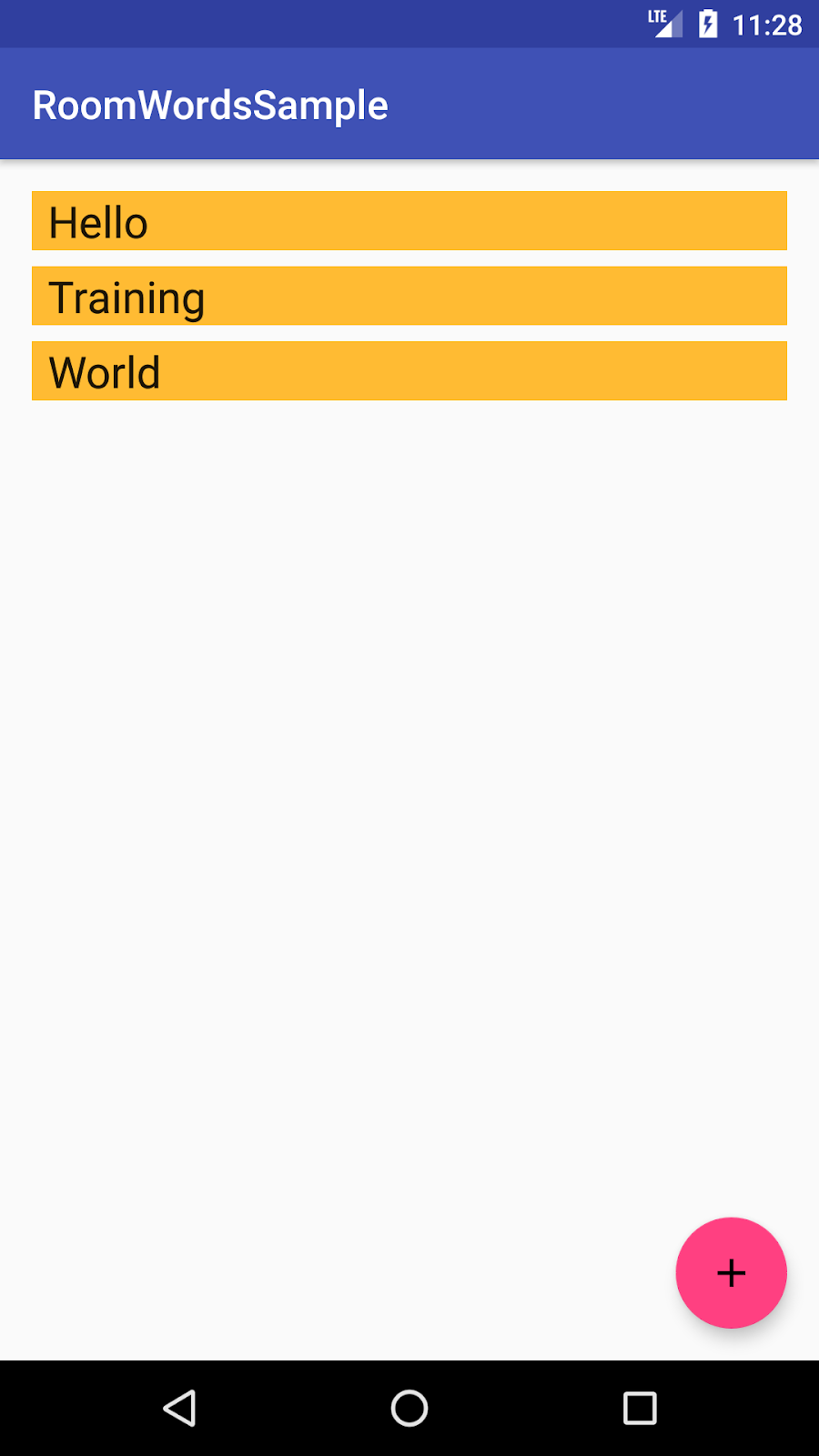1. Before you begin
The Android Architecture Components collection provides guidance on app architecture, with libraries for common tasks like lifecycle management and data persistence. Using architecture components can help you structure your app in a way that is robust, testable, and maintainable, with less boilerplate code.
The Architecture Component libraries are part of Android Jetpack.
This is the Kotlin version of the codelab. The version in the Java programming language can be found here.
If you run into any issues as you work through this codelab, like code bugs, grammatical errors, or simply confusing content, please report the issue via the Report a mistake link in the lower left corner of the codelab.
Prerequisites
You need to be familiar with Kotlin, object-oriented design concepts, and Android development fundamentals, in particular:
RecyclerViewand adapters- SQLite database and the SQLite query language
- Basic coroutines (If you're not familiar with coroutines, you can start with Using Kotlin Coroutines in your Android App.)
It also helps to be familiar with software architectural patterns that separate data from the user interface, such as Model-View-Presenter (MVP) or Model-View-Controller (MVC). This codelab implements the architecture defined in the Guide to app architecture Android developer documentation.
This codelab is focused on Android Architecture Components. Off-topic concepts and code are provided for you to simply copy and paste.
What you'll do
You'll learn how to design and construct an app using the architecture components Room, ViewModel, and LiveData. Your app will:
- implement the recommended architecture using Android Architecture Components.
- work with a database to get and save data, and pre-populate the database with sample words.
- display all the words in a
RecyclerViewin theMainActivityclass. - open a second activity when the user taps the + button. When the user enters a word, that word is added to the database and displayed in the
RecyclerViewlist.
The app is no-frills, but sufficiently complex that you can use it as a template to build upon. Here's a preview:
|
|
|
What you'll need
- Android Studio Arctic Fox, and knowledge of how to use it. Make sure Android Studio is updated, as well as your SDK and Gradle.
- An Android device or emulator.
This codelab provides all the code you need to build the complete app.
2. Using the Architecture Components
Here is a short diagram to introduce you to the Architecture Components and how they work together. Note that this codelab focuses on a subset of the components, namely LiveData, ViewModel and Room. Each component is explained in detail as you use it in your app.
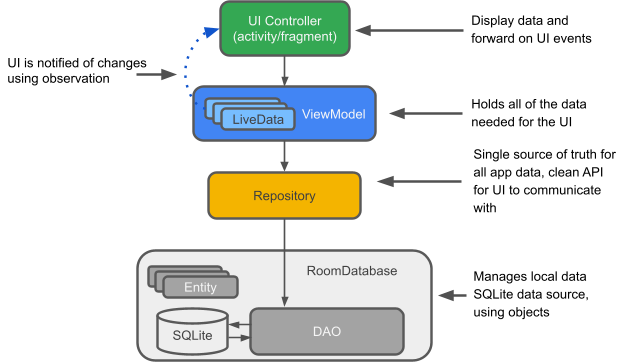
LiveData: A data holder class that can be observed. Always holds/caches the latest version of data, and notifies its observers when data has changed. LiveData is lifecycle aware. UI components just observe relevant data and don't stop or resume observation. LiveData automatically manages all of this since it's aware of the relevant lifecycle status changes while observing.
ViewModel: Acts as a communication center between the Repository (data) and the UI. The UI no longer needs to worry about the origin of the data. ViewModel instances survive Activity/Fragment recreation.
Repository: A class that you create that is primarily used to manage multiple data sources.
Entity: Annotated class that describes a database table when working with Room.
Room database: Simplifies database work and serves as an access point to the underlying SQLite database (hides SQLiteOpenHelper). The Room database uses the DAO to issue queries to the SQLite database.
SQLite database: On device storage. The Room persistence library creates and maintains this database for you.
DAO: Data access object. A mapping of SQL queries to functions. When you use a DAO, you call the methods, and Room takes care of the rest.
RoomWordSample architecture overview
The following diagram shows how all of the pieces of the app should interact. Each of the rectangular boxes (not the SQLite database) represents a class that you will create.
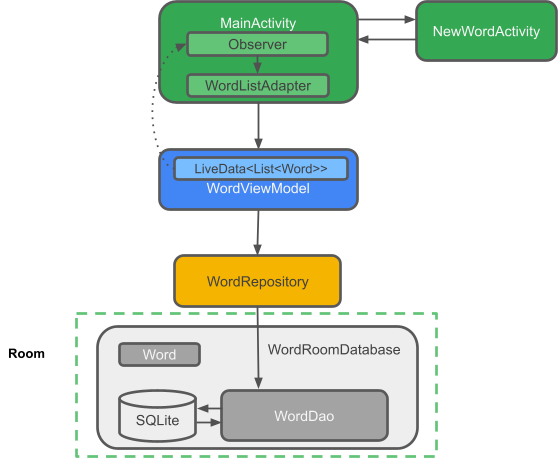
3. Create your app
- Open Android Studio and click Start a new Android Studio project.
- In the Create New Project window, choose Empty Activity, and click Next.
- On the next screen, name the app RoomWordSample, and click Finish.
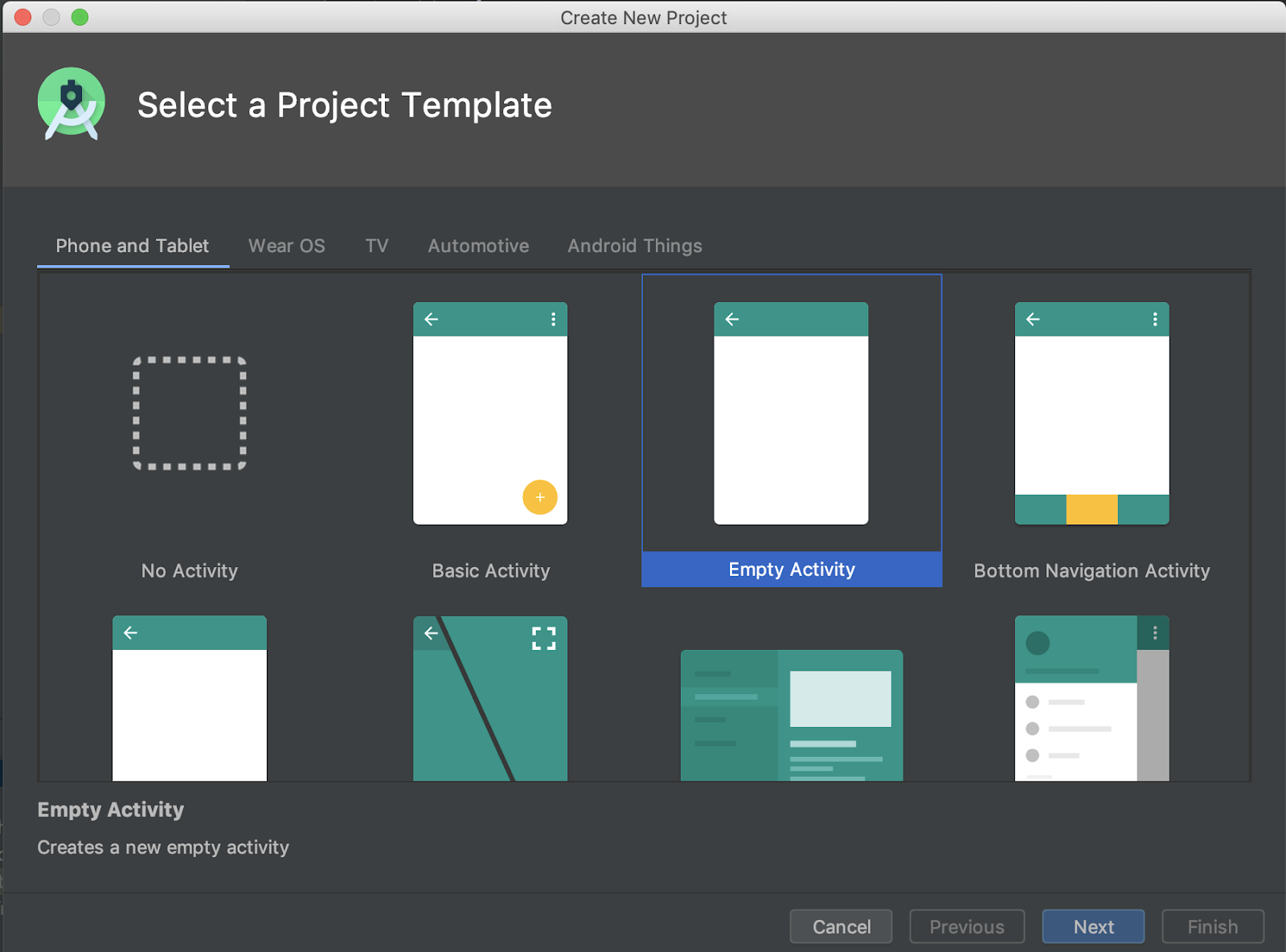
4. Update Gradle files
Next, you'll have to add the component libraries to your Gradle files.
- In Android Studio, click the Projects tab and expand the Gradle Scripts folder.
Open build.gradle (Module: app).
- Apply the
kaptannotation processor Kotlin plugin by adding it in the plugins section defined on the top of yourbuild.gradle(Module: app) file.
plugins {
id 'com.android.application'
id 'kotlin-android'
id 'kotlin-kapt'
}
- Some of the APIs you will use require 1.8
jvmTarget, so add that to theandroidblock as well.
android {
// other configuration (buildTypes, defaultConfig, etc.)
packagingOptions {
exclude 'META-INF/atomicfu.kotlin_module'
}
kotlinOptions {
jvmTarget = "1.8"
}
}
- Replace the
dependenciesblock with:
dependencies {
implementation "androidx.appcompat:appcompat:$rootProject.appCompatVersion"
implementation "androidx.activity:activity-ktx:$rootProject.activityVersion"
// Dependencies for working with Architecture components
// You'll probably have to update the version numbers in build.gradle (Project)
// Room components
implementation "androidx.room:room-ktx:$rootProject.roomVersion"
kapt "androidx.room:room-compiler:$rootProject.roomVersion"
androidTestImplementation "androidx.room:room-testing:$rootProject.roomVersion"
// Lifecycle components
implementation "androidx.lifecycle:lifecycle-viewmodel-ktx:$rootProject.lifecycleVersion"
implementation "androidx.lifecycle:lifecycle-livedata-ktx:$rootProject.lifecycleVersion"
implementation "androidx.lifecycle:lifecycle-common-java8:$rootProject.lifecycleVersion"
// Kotlin components
implementation "org.jetbrains.kotlin:kotlin-stdlib-jdk7:$kotlin_version"
api "org.jetbrains.kotlinx:kotlinx-coroutines-core:$rootProject.coroutines"
api "org.jetbrains.kotlinx:kotlinx-coroutines-android:$rootProject.coroutines"
// UI
implementation "androidx.constraintlayout:constraintlayout:$rootProject.constraintLayoutVersion"
implementation "com.google.android.material:material:$rootProject.materialVersion"
// Testing
testImplementation "junit:junit:$rootProject.junitVersion"
androidTestImplementation "androidx.arch.core:core-testing:$rootProject.coreTestingVersion"
androidTestImplementation ("androidx.test.espresso:espresso-core:$rootProject.espressoVersion", {
exclude group: 'com.android.support', module: 'support-annotations'
})
androidTestImplementation "androidx.test.ext:junit:$rootProject.androidxJunitVersion"
}
Gradle may complain about missing or undefined versions at this point. They should be fixed with the next step.
- In your
build.gradle(Project: RoomWordsSample) file, make the following changes: at the top of the buildscript block add the kotlin_version and then, add the version numbers to the end of the file, as given in the code below.
buildscript {
ext.kotlin_version = '1.5.31'
...
}
ext {
activityVersion = '1.4.0'
appCompatVersion = '1.4.0'
constraintLayoutVersion = '2.1.2'
coreTestingVersion = '2.1.0'
coroutines = '1.5.2'
lifecycleVersion = '2.4.0'
materialVersion = '1.4.0'
roomVersion = '2.3.0'
// testing
junitVersion = '4.13.2'
espressoVersion = '3.4.0'
androidxJunitVersion = '1.1.3'
}
5. Create an Entity
The data for this app is words, and you will need a simple table to hold those values:
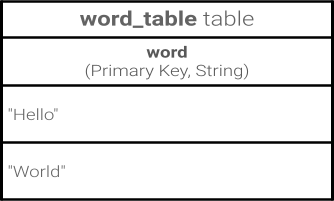
Room allows you to create tables via an Entity. Let's do this now.
- Create a new Kotlin class file called
Wordcontaining theWorddata class. This class will describe the Entity (which represents the SQLite table) for your words. Each property in the class represents a column in the table. Room will ultimately use these properties to both create the table and instantiate objects from rows in the database.
Here is the code:
data class Word(val word: String)
To make the Word class meaningful to a Room database, you need to create an association between the class and the database using Kotlin annotations. You will use specific annotations to identify how each part of this class relates to an entry in the database. Room uses this extra information to generate code.
If you type the annotations yourself (instead of pasting), Android Studio will auto-import the annotation classes.
- Update your
Wordclass with annotations as shown in this code:
@Entity(tableName = "word_table")
class Word(@PrimaryKey @ColumnInfo(name = "word") val word: String)
Let's see what these annotations do:
@Entity(tableName ="word_table")Each@Entityclass represents a SQLite table. Annotate your class declaration to indicate that it's an entity. You can specify the name of the table if you want it to be different from the name of the class. This names the table "word_table".@PrimaryKeyEvery entity needs a primary key. To keep things simple, each word acts as its own primary key.@ColumnInfo(name ="word")Specifies the name of the column in the table if you want it to be different from the name of the member variable. This names the column "word".- Every property that's stored in the database needs to have public visibility, which is the Kotlin default.
You can find a complete list of annotations in the Room package summary reference.
Tip: You can autogenerate unique keys by annotating the primary key as follows:
@Entity(tableName = "word_table")
class Word(
@PrimaryKey(autoGenerate = true) val id: Int,
@ColumnInfo(name = "word") val word: String
)
6. Create the DAO
What is the DAO?
In the DAO (data access object), you specify SQL queries and associate them with method calls. The compiler checks the SQL and generates queries from convenience annotations for common queries, such as @Insert. Room uses the DAO to create a clean API for your code.
The DAO must be an interface or abstract class.
By default, all queries must be executed on a separate thread.
Room has Kotlin coroutines support. This allows your queries to be annotated with the suspend modifier and then called from a coroutine or from another suspension function.
Implement the DAO
Let's write a DAO that provides queries for:
- Getting all words ordered alphabetically
- Inserting a word
- Deleting all words
- Create a new Kotlin class file called
WordDao. - Copy and paste the following code into
WordDaoand fix the imports as necessary to make it compile.
@Dao
interface WordDao {
@Query("SELECT * FROM word_table ORDER BY word ASC")
fun getAlphabetizedWords(): List<Word>
@Insert(onConflict = OnConflictStrategy.IGNORE)
suspend fun insert(word: Word)
@Query("DELETE FROM word_table")
suspend fun deleteAll()
}
Let's walk through it:
WordDaois an interface; DAOs must either be interfaces or abstract classes.- The
@Daoannotation identifies it as a DAO class for Room. suspend fun insert(word: Word): Declares a suspend function to insert one word.- The
@Insertannotation is a special DAO method annotation where you don't have to provide any SQL! (There are also@Deleteand@Updateannotations for deleting and updating rows, but you are not using them in this app.) onConflict = OnConflictStrategy.IGNORE: The selected onConflict strategy ignores a new word if it's exactly the same as one already in the list. To know more about the available conflict strategies, check out the documentation.suspend fun deleteAll(): Declares a suspend function to delete all the words.- There is no convenience annotation for deleting multiple entities, so it's annotated with the generic
@Query. @Query("DELETE FROM word_table"):@Queryrequires that you provide a SQL query as a string parameter to the annotation, allowing for complex read queries and other operations.fun getAlphabetizedWords(): List<Word>: A method to get all the words and have it return aListofWords.@Query("SELECT * FROM word_table ORDER BY word ASC"): Query that returns a list of words sorted in ascending order.
7. Observing database changes
When data changes, you usually want to take some action, such as displaying the updated data in the UI. This means you have to observe the data so when it changes, you can react.
To observe data changes you will use Flow from kotlinx-coroutines. Use a return value of type Flow in your method description, and Room generates all necessary code to update the Flow when the database is updated.
In WordDao, change the getAlphabetizedWords() method signature so that the returned List<Word> is wrapped with Flow.
@Query("SELECT * FROM word_table ORDER BY word ASC")
fun getAlphabetizedWords(): Flow<List<Word>>
Later in this codelab, we'll transform the Flow to LiveData in the ViewModel. But more on these components once we get to implement them.
8. Add a Room database
What is a Room database**?**
- Room is a database layer on top of an SQLite database.
- Room takes care of mundane tasks that you used to handle with an
SQLiteOpenHelper. - Room uses the DAO to issue queries to its database.
- By default, to avoid poor UI performance, Room doesn't allow you to issue queries on the main thread. When Room queries return
Flow, the queries are automatically run asynchronously on a background thread. - Room provides compile-time checks of SQLite statements.
Implement the Room database
Your Room database class must be abstract and extend RoomDatabase. Usually, you only need one instance of a Room database for the whole app.
Let's make one now.
- Create a Kotlin class file called
WordRoomDatabaseand add this code to it:
// Annotates class to be a Room Database with a table (entity) of the Word class
@Database(entities = arrayOf(Word::class), version = 1, exportSchema = false)
public abstract class WordRoomDatabase : RoomDatabase() {
abstract fun wordDao(): WordDao
companion object {
// Singleton prevents multiple instances of database opening at the
// same time.
@Volatile
private var INSTANCE: WordRoomDatabase? = null
fun getDatabase(context: Context): WordRoomDatabase {
// if the INSTANCE is not null, then return it,
// if it is, then create the database
return INSTANCE ?: synchronized(this) {
val instance = Room.databaseBuilder(
context.applicationContext,
WordRoomDatabase::class.java,
"word_database"
).build()
INSTANCE = instance
// return instance
instance
}
}
}
}
Let's walk through the code:
- The database class for Room must be
abstractand extendRoomDatabase. - You annotate the class to be a Room database with
@Databaseand use the annotation parameters to declare the entities that belong in the database and set the version number. Each entity corresponds to a table that will be created in the database. Database migrations are beyond the scope of this codelab, soexportSchemahas been set to false here, in order to avoid a build warning. In a real app, consider setting a directory for Room to use to export the schema so you can check the current schema into your version control system. - The database exposes DAOs through an abstract "getter" method for each @Dao.
- You defined a singleton,
WordRoomDatabase,to prevent having multiple instances of the database opened at the same time. getDatabasereturns the singleton. It'll create the database the first time it's accessed, using Room's database builder to create aRoomDatabaseobject in the application context from theWordRoomDatabaseclass and names it"word_database".
9. Create the Repository
What is a Repository?
A repository class abstracts access to multiple data sources. The repository is not part of the Architecture Components libraries, but is a suggested best practice for code separation and architecture. A Repository class provides a clean API for data access to the rest of the application.
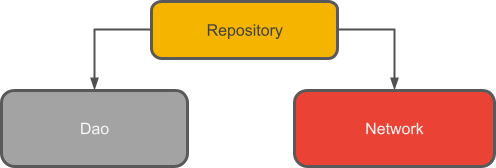
Why use a Repository?
A Repository manages queries and allows you to use multiple backends. In the most common example, the Repository implements the logic for deciding whether to fetch data from a network or use results cached in a local database.
Implementing the Repository
Create a Kotlin class file called WordRepository and paste the following code into it:
// Declares the DAO as a private property in the constructor. Pass in the DAO
// instead of the whole database, because you only need access to the DAO
class WordRepository(private val wordDao: WordDao) {
// Room executes all queries on a separate thread.
// Observed Flow will notify the observer when the data has changed.
val allWords: Flow<List<Word>> = wordDao.getAlphabetizedWords()
// By default Room runs suspend queries off the main thread, therefore, we don't need to
// implement anything else to ensure we're not doing long running database work
// off the main thread.
@Suppress("RedundantSuspendModifier")
@WorkerThread
suspend fun insert(word: Word) {
wordDao.insert(word)
}
}
The main takeaways:
- The DAO is passed into the repository constructor as opposed to the whole database. This is because it only needs access to the DAO, since the DAO contains all the read/write methods for the database. There's no need to expose the entire database to the repository.
- The list of words is a public property. It's initialized by getting the
Flowlist of words from Room; you can do this because of how you defined thegetAlphabetizedWordsmethod to returnFlowin the "Observing database changes" step. Room executes all queries on a separate thread. - The
suspendmodifier tells the compiler that this needs to be called from a coroutine or another suspending function. - Room executes suspend queries off the main thread.
10. Create the ViewModel
What is a ViewModel?
The ViewModel's role is to provide data to the UI and survive configuration changes. A ViewModel acts as a communication center between the Repository and the UI. You can also use a ViewModel to share data between fragments. The ViewModel is part of the lifecycle library.
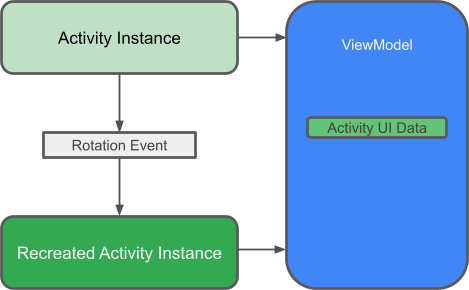
For an introductory guide to this topic, see ViewModel Overview or the ViewModels: A Simple Example blog post.
Why use a ViewModel?
A ViewModel holds your app's UI data in a lifecycle-conscious way that survives configuration changes. Separating your app's UI data from your Activity and Fragment classes lets you better follow the single responsibility principle: Your activities and fragments are responsible for drawing data to the screen, while your ViewModel can take care of holding and processing all the data needed for the UI.
LiveData and ViewModel
LiveData is an observable data holder - you can get notified every time the data changes. Unlike Flow, LiveData is lifecycle aware, meaning that it will respect the lifecycle of other components like Activity or Fragment. LiveData automatically stops or resumes observation depending on the lifecycle of the component that listens for changes. This makes LiveData the perfect component to be used for for changeable data that the UI will use or display.
The ViewModel will transform the data from the Repository, from Flow to LiveData and expose the list of words as LiveData to the UI. This ensures that every time the data changes in the database, your UI is automatically updated.
viewModelScope
In Kotlin, all coroutines run inside a CoroutineScope. A scope controls the lifetime of coroutines through its job. When you cancel the job of a scope, it cancels all coroutines started in that scope.
The AndroidX lifecycle-viewmodel-ktx library adds a viewModelScope as an extension function of the ViewModel class, enabling you to work with scopes.
To find out more about working with coroutines in the ViewModel, check out Step 5 of the Using Kotlin Coroutines in your Android App codelab or the Easy Coroutines in Android: viewModelScope blogpost.
Implement the ViewModel
Create a Kotlin class file for WordViewModel and add this code to it:
class WordViewModel(private val repository: WordRepository) : ViewModel() {
// Using LiveData and caching what allWords returns has several benefits:
// - We can put an observer on the data (instead of polling for changes) and only update the
// the UI when the data actually changes.
// - Repository is completely separated from the UI through the ViewModel.
val allWords: LiveData<List<Word>> = repository.allWords.asLiveData()
/**
* Launching a new coroutine to insert the data in a non-blocking way
*/
fun insert(word: Word) = viewModelScope.launch {
repository.insert(word)
}
}
class WordViewModelFactory(private val repository: WordRepository) : ViewModelProvider.Factory {
override fun <T : ViewModel> create(modelClass: Class<T>): T {
if (modelClass.isAssignableFrom(WordViewModel::class.java)) {
@Suppress("UNCHECKED_CAST")
return WordViewModel(repository) as T
}
throw IllegalArgumentException("Unknown ViewModel class")
}
}
Let's break down this code. Here, you have:
- created a class called
WordViewModelthat gets theWordRepositoryas a parameter and extendsViewModel. The Repository is the only dependency that the ViewModel needs. If other classes would have been needed, they would have been passed in the constructor as well. - added a public
LiveDatamember variable to cache the list of words. - initialized
LiveDatawith theallWordsFlow from the Repository. You then converted the Flow to LiveData by callingasLiveData(). - created a wrapper
insert()method that calls the Repository'sinsert()method. This way, the implementation ofinsert()is encapsulated from the UI. We're launching a new coroutine and calling the repository's insert, which is a suspend function. As mentioned, ViewModels have a coroutine scope based on their lifecycle calledviewModelScope, which you'll use here. - created the ViewModel and implemented a
ViewModelProvider.Factorythat gets as a parameter the dependencies needed to createWordViewModel: theWordRepository.
By using viewModels and ViewModelProvider.Factory,the framework will take care of the lifecycle of the ViewModel. It will survive configuration changes and even if the Activity is recreated, you'll always get the right instance of the WordViewModel class.
11. Add XML layout
Next, you need to add the XML layout for the list and items.
This codelab assumes that you are familiar with creating layouts in XML, so we are just providing you with the code.
Make your application theme material by setting the AppTheme parent to Theme.MaterialComponents.Light.DarkActionBar. Add a style for list items in values/styles.xml:
<resources>
<!-- Base application theme. -->
<style name="AppTheme" parent="Theme.MaterialComponents.Light.DarkActionBar">
<!-- Customize your theme here. -->
<item name="colorPrimary">@color/colorPrimary</item>
<item name="colorPrimaryDark">@color/colorPrimaryDark</item>
<item name="colorAccent">@color/colorAccent</item>
</style>
<!-- The default font for RecyclerView items is too small.
The margin is a simple delimiter between the words. -->
<style name="word_title">
<item name="android:layout_marginBottom">8dp</item>
<item name="android:paddingLeft">8dp</item>
<item name="android:background">@android:color/holo_orange_light</item>
<item name="android:textAppearance">@android:style/TextAppearance.Large</item>
</style>
</resources>
Create a new dimension resource file:
- Click the app module in the Project window.
- Select File > New > Android Resource File.
- From the Available Qualifiers, select Dimension.
- Name the file: dimens
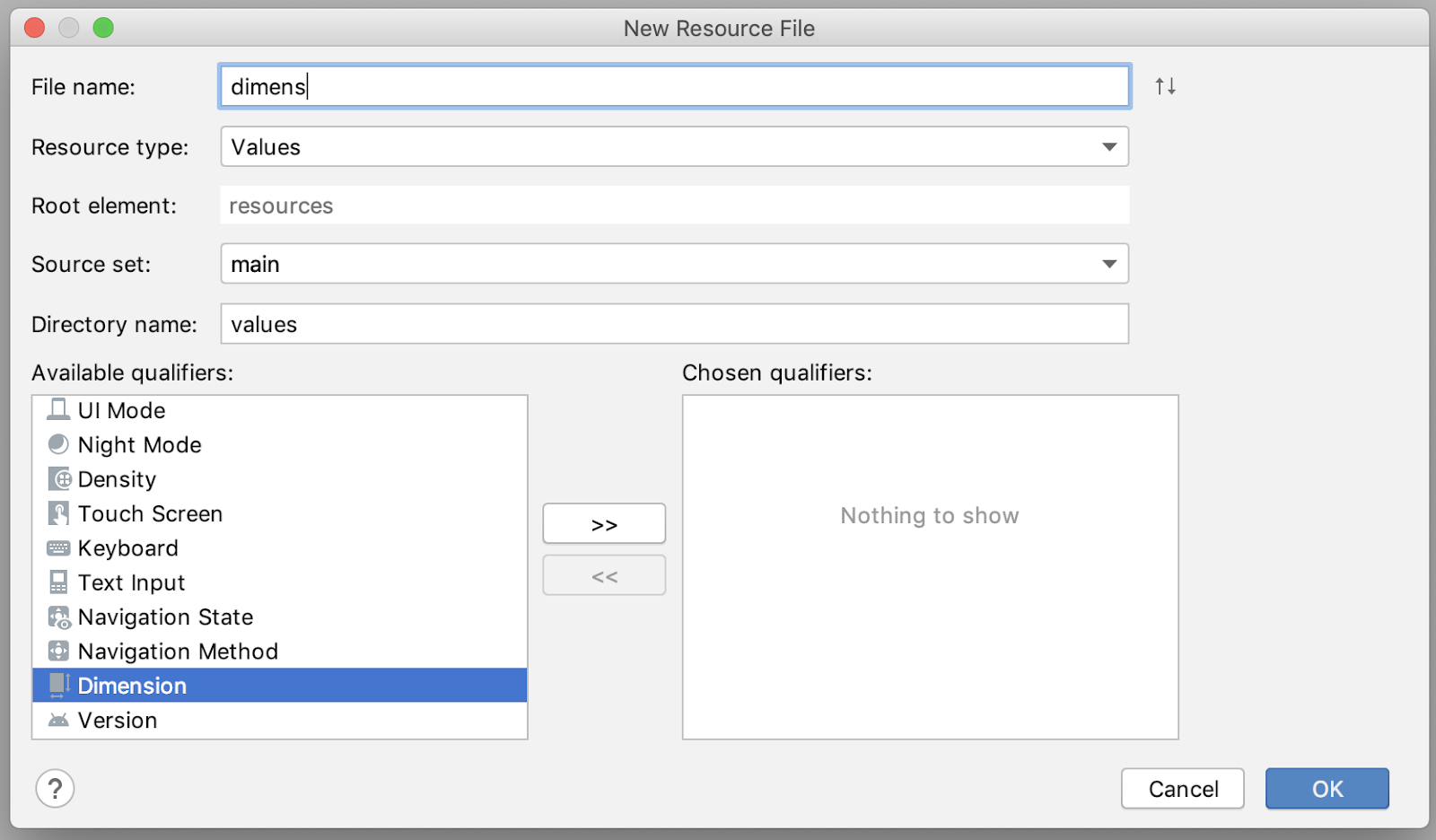
Add this dimension resources in values/dimens.xml:
<dimen name="big_padding">16dp</dimen>
Add a layout/recyclerview_item.xml layout:
<?xml version="1.0" encoding="utf-8"?>
<LinearLayout xmlns:android="http://schemas.android.com/apk/res/android"
android:orientation="vertical"
android:layout_width="match_parent"
android:layout_height="wrap_content">
<TextView
android:id="@+id/textView"
style="@style/word_title"
android:layout_width="match_parent"
android:layout_height="wrap_content"
android:background="@android:color/holo_orange_light" />
</LinearLayout>
In layout/activity_main.xml, replace the TextView with a RecyclerView and add a floating action button (FAB). Now your layout should look like this:
<androidx.constraintlayout.widget.ConstraintLayout
xmlns:android="http://schemas.android.com/apk/res/android"
xmlns:app="http://schemas.android.com/apk/res-auto"
xmlns:tools="http://schemas.android.com/tools"
android:layout_width="match_parent"
android:layout_height="match_parent"
tools:context=".MainActivity">
<androidx.recyclerview.widget.RecyclerView
android:id="@+id/recyclerview"
android:layout_width="0dp"
android:layout_height="0dp"
tools:listitem="@layout/recyclerview_item"
android:padding="@dimen/big_padding"
app:layout_constraintBottom_toBottomOf="parent"
app:layout_constraintLeft_toLeftOf="parent"
app:layout_constraintRight_toRightOf="parent"
app:layout_constraintTop_toTopOf="parent" />
<com.google.android.material.floatingactionbutton.FloatingActionButton
android:id="@+id/fab"
app:layout_constraintBottom_toBottomOf="parent"
app:layout_constraintEnd_toEndOf="parent"
android:layout_width="wrap_content"
android:layout_height="wrap_content"
android:layout_margin="16dp"
android:contentDescription="@string/add_word"/>
</androidx.constraintlayout.widget.ConstraintLayout>
Your FAB's appearance should correspond to the available action, so you'll want to replace the icon with a ‘+' symbol.
First, you need to add a new Vector Asset:
- Select File > New > Vector Asset.
- Click the Android robot icon in the Clip Art: field.
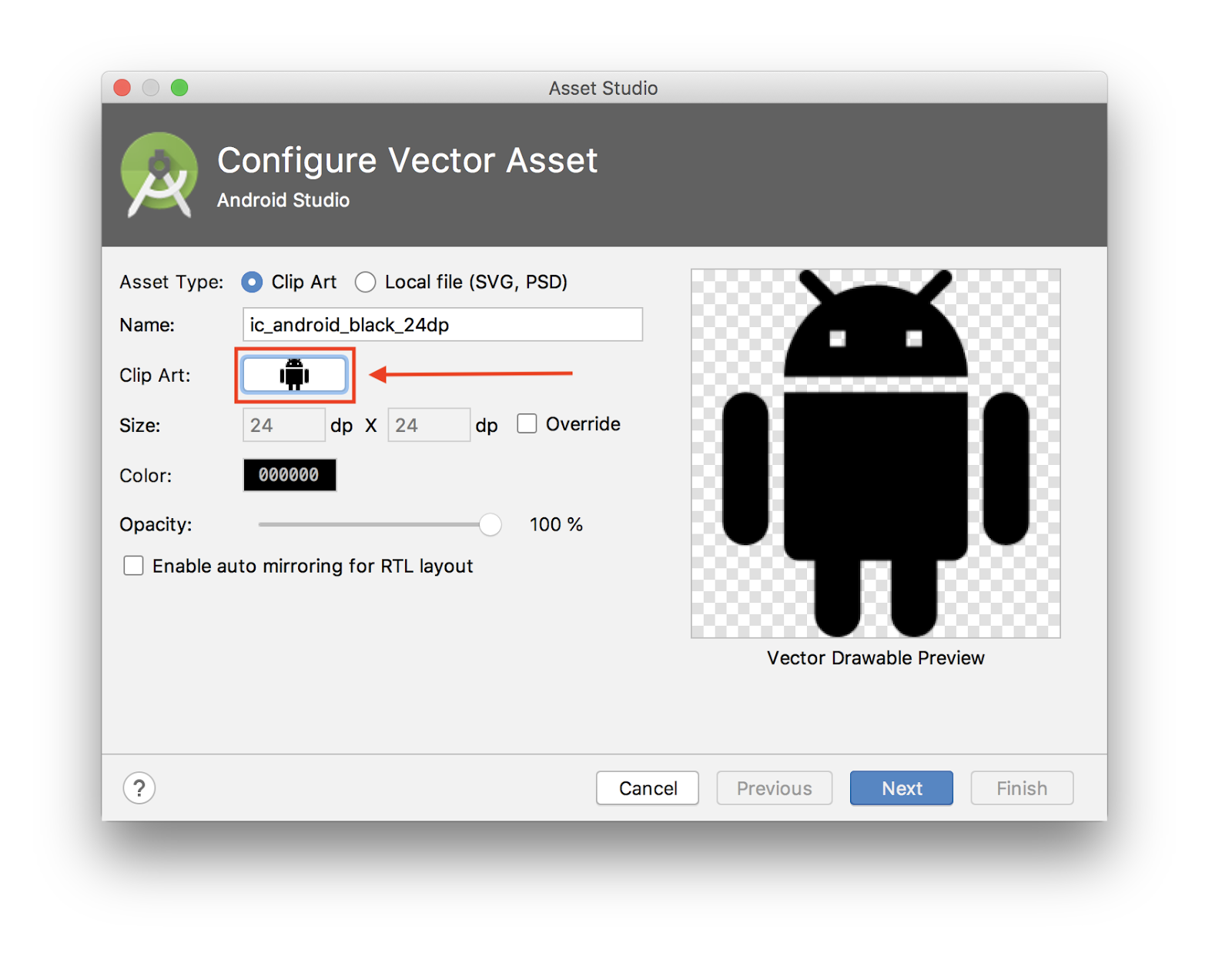
- Search for "add" and select the ‘+' asset. Click OK.
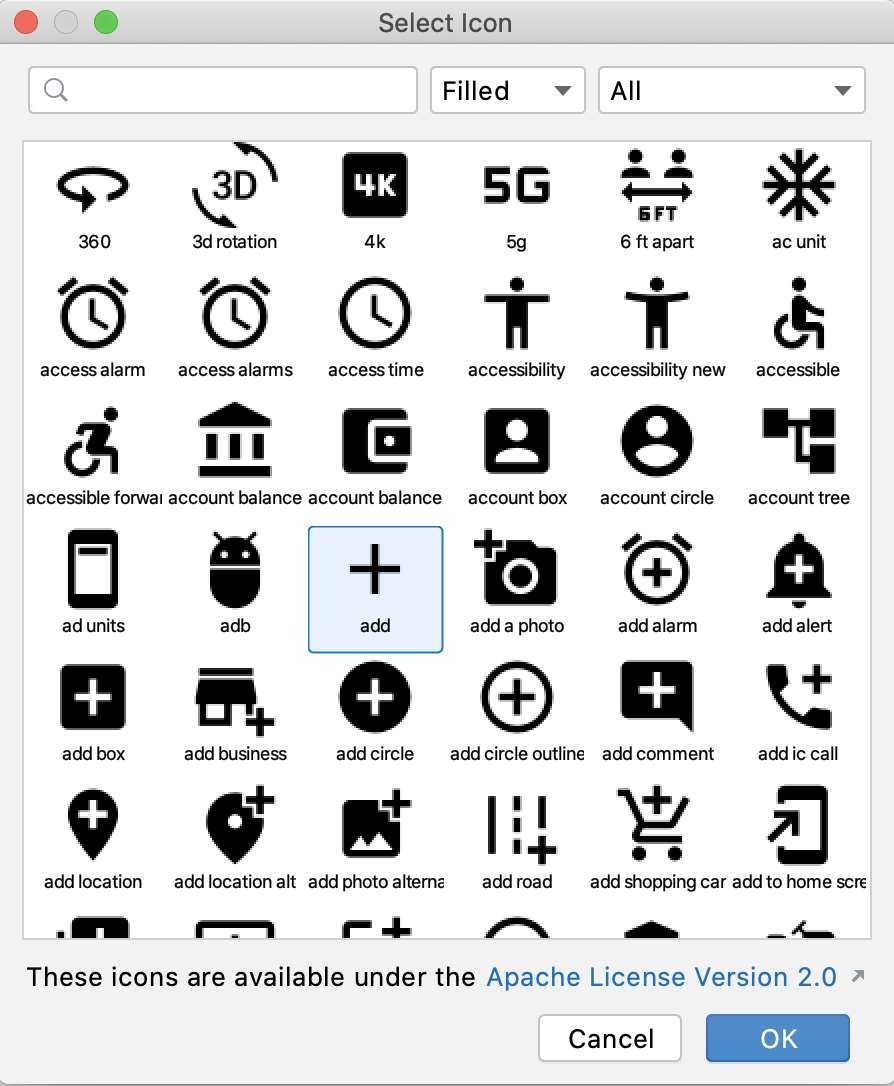
- On the Asset Studio window, click Next.
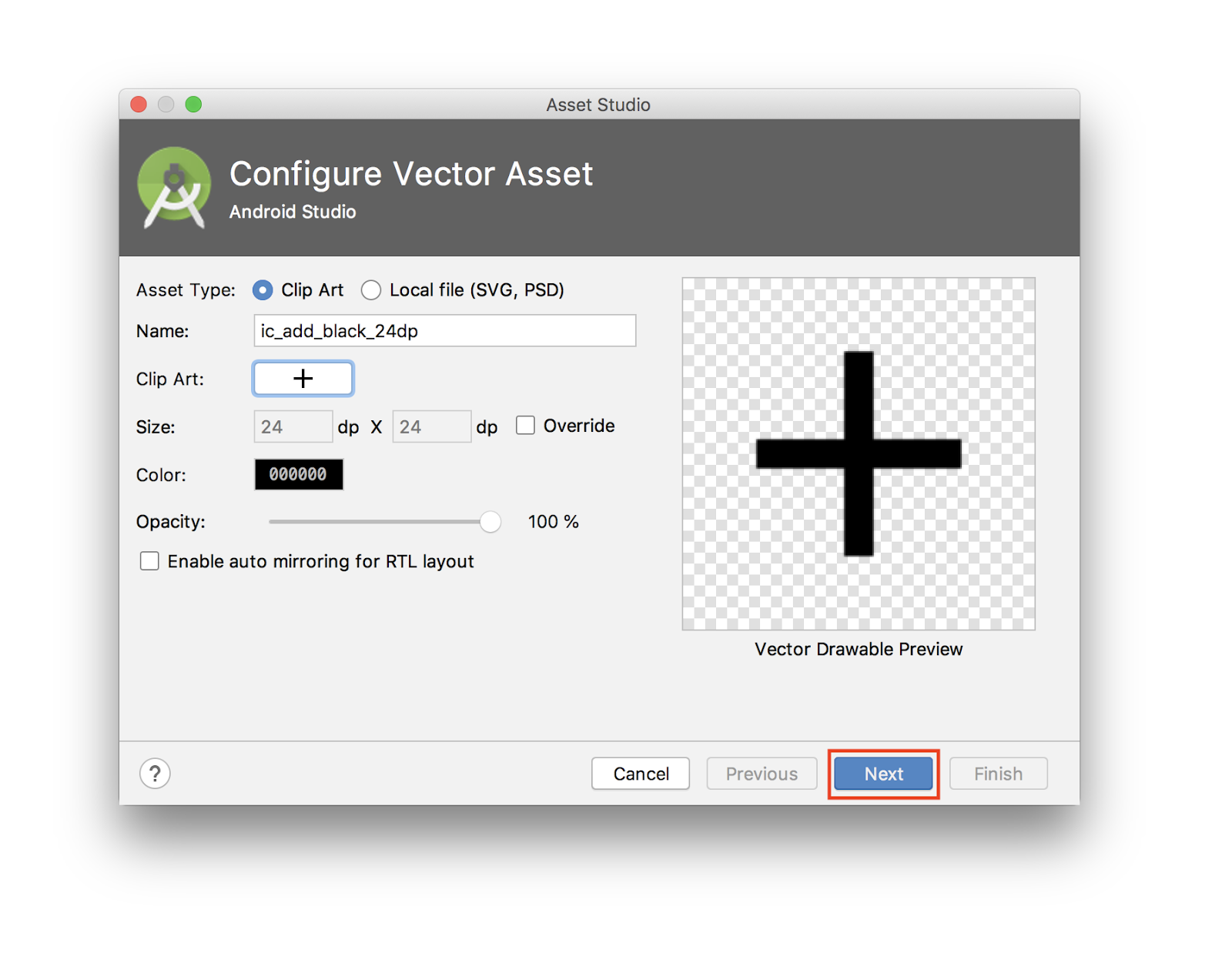
- Confirm the icon path as
main > drawableand click Finish to add the asset.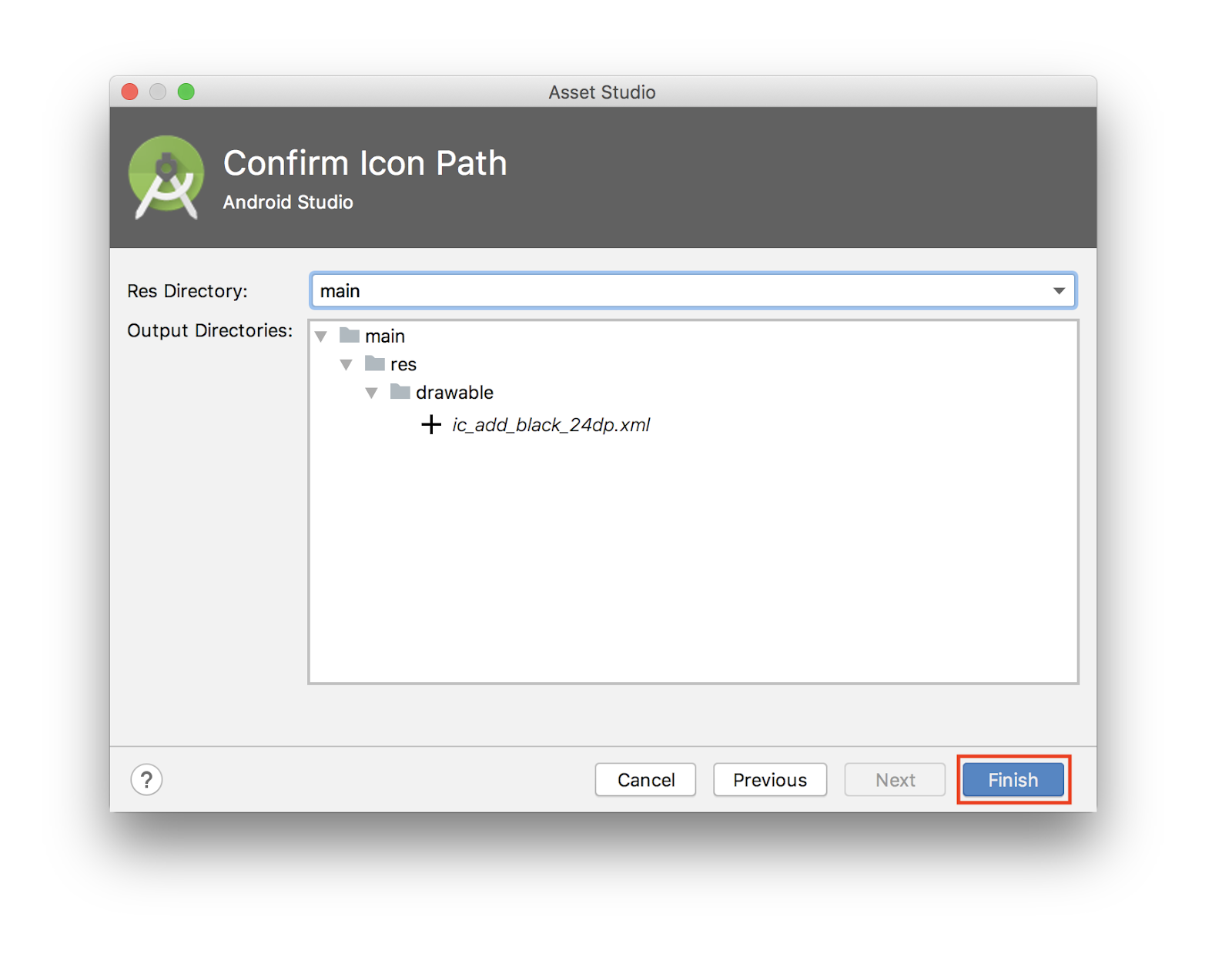
- Still in
layout/activity_main.xml, update the FAB to include the new drawable:
<com.google.android.material.floatingactionbutton.FloatingActionButton
android:id="@+id/fab"
app:layout_constraintBottom_toBottomOf="parent"
app:layout_constraintEnd_toEndOf="parent"
android:layout_width="wrap_content"
android:layout_height="wrap_content"
android:layout_margin="16dp"
android:contentDescription="@string/add_word"
android:src="@drawable/ic_add_black_24dp"/>
12. Add a RecyclerView
You are going to display the data in a RecyclerView, which is a little nicer than just throwing the data in a TextView. This codelab assumes that you know how RecyclerView, RecyclerView.ViewHolder, and ListAdapter work.
You'll need to create:
- The
WordListAdapterclass that extendsListAdapter. - A nested
DiffUtil.ItemCallbackclass part of theWordListAdapter. - The
ViewHolderthat will display each word in our list.
Here is the code:
class WordListAdapter : ListAdapter<Word, WordViewHolder>(WordsComparator()) {
override fun onCreateViewHolder(parent: ViewGroup, viewType: Int): WordViewHolder {
return WordViewHolder.create(parent)
}
override fun onBindViewHolder(holder: WordViewHolder, position: Int) {
val current = getItem(position)
holder.bind(current.word)
}
class WordViewHolder(itemView: View) : RecyclerView.ViewHolder(itemView) {
private val wordItemView: TextView = itemView.findViewById(R.id.textView)
fun bind(text: String?) {
wordItemView.text = text
}
companion object {
fun create(parent: ViewGroup): WordViewHolder {
val view: View = LayoutInflater.from(parent.context)
.inflate(R.layout.recyclerview_item, parent, false)
return WordViewHolder(view)
}
}
}
class WordsComparator : DiffUtil.ItemCallback<Word>() {
override fun areItemsTheSame(oldItem: Word, newItem: Word): Boolean {
return oldItem === newItem
}
override fun areContentsTheSame(oldItem: Word, newItem: Word): Boolean {
return oldItem.word == newItem.word
}
}
}
Here you have:
- The
WordViewHolderclass, that allows us to bind a text to aTextView. The class exposes a staticcreate()function that handles inflating the layout. - The
WordsComparatordefines how to compute if two words are the same or if the contents are the same. - The
WordListAdaptercreates theWordViewHolderinonCreateViewHolderand binds it inonBindViewHolder.
Add the RecyclerView in the onCreate() method of MainActivity.
In the onCreate() method after setContentView:
val recyclerView = findViewById<RecyclerView>(R.id.recyclerview)
val adapter = WordListAdapter()
recyclerView.adapter = adapter
recyclerView.layoutManager = LinearLayoutManager(this)
Run your app to make sure everything works. There are no items, because you have not hooked up the data yet.
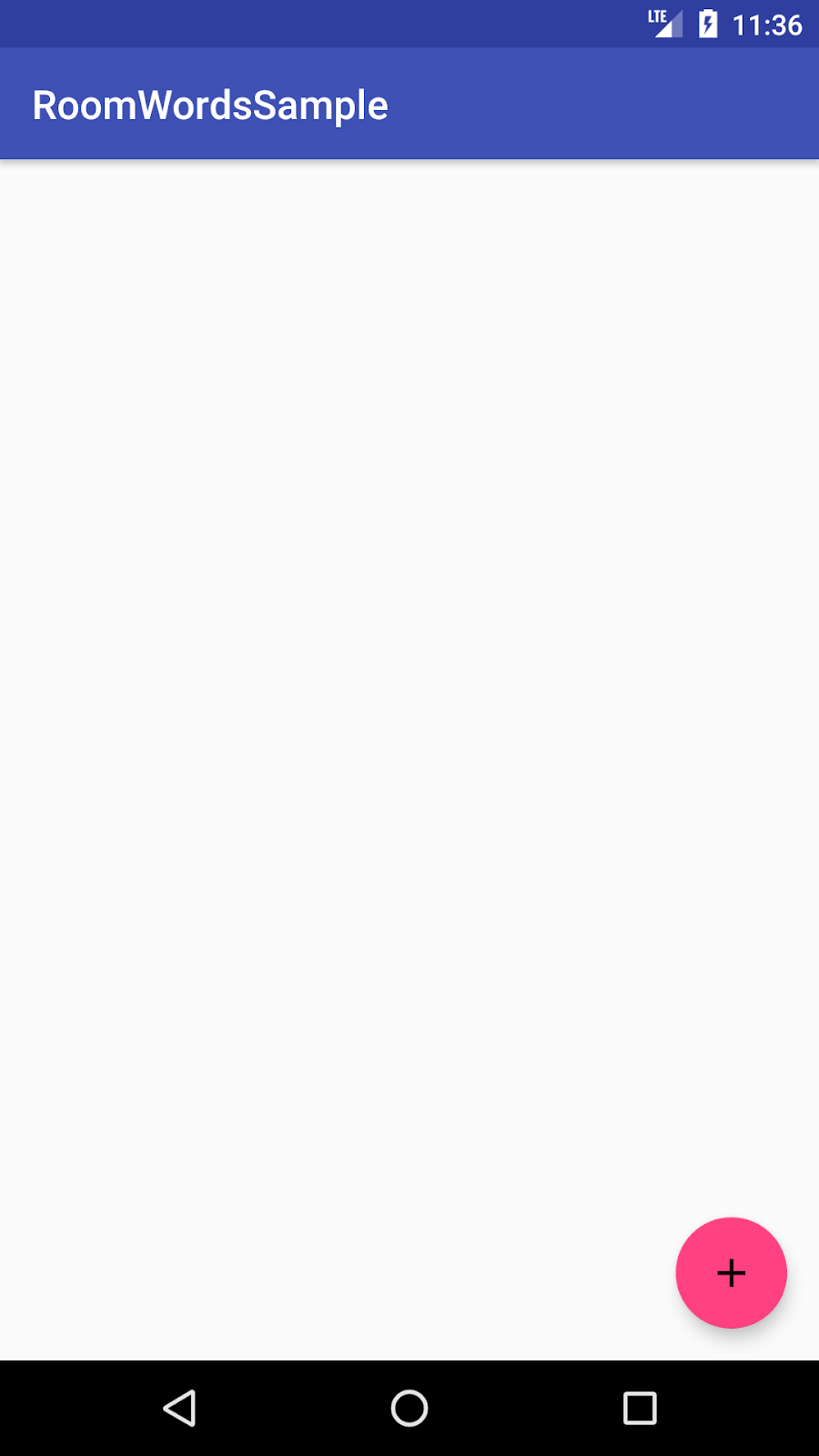
13. Instantiate the repository and the database
You want to have only one instance of the database and of the repository in your app. An easy way to achieve this is by creating them as members of the Application class. Then they will just be retrieved from the Application whenever they're needed, rather than constructed every time.
Create a new class called WordsApplication that extends Application. Here's the code:
class WordsApplication : Application() {
// Using by lazy so the database and the repository are only created when they're needed
// rather than when the application starts
val database by lazy { WordRoomDatabase.getDatabase(this) }
val repository by lazy { WordRepository(database.wordDao()) }
}
Here's what you've done:
- Created a database instance.
- Created a repository instance, based on the database DAO.
- Because these objects should only be created when they're first needed, rather than at app startup, you're using Kotlin's property delegation:
by lazy.
Now that you created the Application class, update the AndroidManifest file and set WordsApplication as application android:name.
Here's how the application tag should look:
<application
android:name=".WordsApplication"
android:allowBackup="true"
android:icon="@mipmap/ic_launcher"
android:label="@string/app_name"
android:roundIcon="@mipmap/ic_launcher_round"
android:supportsRtl="true"
android:theme="@style/AppTheme">
...
14. Populate the database
At the moment, there is no data in the database. You will add data in two ways: Add some data when the database is created, and add an Activity for adding words.
To delete all content and repopulate the database whenever the app is created, you'll create a RoomDatabase.Callback and override onCreate(). Because you cannot do Room database operations on the UI thread, onCreate() launches a coroutine on the IO Dispatcher.
To launch a coroutine you need a CoroutineScope. Update the getDatabase method of the WordRoomDatabase class, to also get a coroutine scope as parameter:
fun getDatabase(
context: Context,
scope: CoroutineScope
): WordRoomDatabase {
...
}
Populating the database isn't related to a UI lifecycle, therefore you shouldn't use a CoroutineScope like viewModelScope. It's related to the app's lifecycle. You'll update the WordsApplication to contain an applicationScope, then pass that to the WordRoomDatabase.getDatabase.
class WordsApplication : Application() {
// No need to cancel this scope as it'll be torn down with the process
val applicationScope = CoroutineScope(SupervisorJob())
// Using by lazy so the database and the repository are only created when they're needed
// rather than when the application starts
val database by lazy { WordRoomDatabase.getDatabase(this, applicationScope) }
val repository by lazy { WordRepository(database.wordDao()) }
}
In the WordRoomDatabase, you'll create a custom implementation of the RoomDatabase.Callback(), that also gets a CoroutineScope as constructor parameter. Then, you override the onCreate method to populate the database.
Here is the code for creating the callback within the WordRoomDatabase class:
private class WordDatabaseCallback(
private val scope: CoroutineScope
) : RoomDatabase.Callback() {
override fun onCreate(db: SupportSQLiteDatabase) {
super.onCreate(db)
INSTANCE?.let { database ->
scope.launch {
populateDatabase(database.wordDao())
}
}
}
suspend fun populateDatabase(wordDao: WordDao) {
// Delete all content here.
wordDao.deleteAll()
// Add sample words.
var word = Word("Hello")
wordDao.insert(word)
word = Word("World!")
wordDao.insert(word)
// TODO: Add your own words!
}
}
Finally, add the callback to the database build sequence right before calling .build() on the Room.databaseBuilder():
.addCallback(WordDatabaseCallback(scope))
Here is what the final code should look like:
@Database(entities = arrayOf(Word::class), version = 1, exportSchema = false)
abstract class WordRoomDatabase : RoomDatabase() {
abstract fun wordDao(): WordDao
private class WordDatabaseCallback(
private val scope: CoroutineScope
) : RoomDatabase.Callback() {
override fun onCreate(db: SupportSQLiteDatabase) {
super.onCreate(db)
INSTANCE?.let { database ->
scope.launch {
var wordDao = database.wordDao()
// Delete all content here.
wordDao.deleteAll()
// Add sample words.
var word = Word("Hello")
wordDao.insert(word)
word = Word("World!")
wordDao.insert(word)
// TODO: Add your own words!
word = Word("TODO!")
wordDao.insert(word)
}
}
}
}
companion object {
@Volatile
private var INSTANCE: WordRoomDatabase? = null
fun getDatabase(
context: Context,
scope: CoroutineScope
): WordRoomDatabase {
// if the INSTANCE is not null, then return it,
// if it is, then create the database
return INSTANCE ?: synchronized(this) {
val instance = Room.databaseBuilder(
context.applicationContext,
WordRoomDatabase::class.java,
"word_database"
)
.addCallback(WordDatabaseCallback(scope))
.build()
INSTANCE = instance
// return instance
instance
}
}
}
}
15. Add NewWordActivity
Add these string resources in values/strings.xml:
<string name="hint_word">Word...</string>
<string name="button_save">Save</string>
<string name="empty_not_saved">Word not saved because it is empty.</string>
<string name="add_word">Add word</string>
Add this color resource in value/colors.xml:
<color name="buttonLabel">#FFFFFF</color>
Add a min_height dimension resource in values/dimens.xml:
<dimen name="min_height">48dp</dimen>
Create a new empty Android Activity with the Empty Activity template:
- Select File > New > Activity > Empty Activity
- Enter
NewWordActivityfor the Activity name. - Verify that the new activity has been added to the Android Manifest.
<activity android:name=".NewWordActivity"></activity>
Update the activity_new_word.xml file in the layout folder with the following code:
<LinearLayout xmlns:android="http://schemas.android.com/apk/res/android"
android:orientation="vertical"
android:layout_width="match_parent"
android:layout_height="match_parent">
<EditText
android:id="@+id/edit_word"
android:layout_width="match_parent"
android:layout_height="wrap_content"
android:minHeight="@dimen/min_height"
android:fontFamily="sans-serif-light"
android:hint="@string/hint_word"
android:inputType="textAutoComplete"
android:layout_margin="@dimen/big_padding"
android:textSize="18sp" />
<Button
android:id="@+id/button_save"
android:layout_width="match_parent"
android:layout_height="wrap_content"
android:background="@color/colorPrimary"
android:text="@string/button_save"
android:layout_margin="@dimen/big_padding"
android:textColor="@color/buttonLabel" />
</LinearLayout>
Update the code for the activity:
class NewWordActivity : AppCompatActivity() {
private lateinit var editWordView: EditText
public override fun onCreate(savedInstanceState: Bundle?) {
super.onCreate(savedInstanceState)
setContentView(R.layout.activity_new_word)
editWordView = findViewById(R.id.edit_word)
val button = findViewById<Button>(R.id.button_save)
button.setOnClickListener {
val replyIntent = Intent()
if (TextUtils.isEmpty(editWordView.text)) {
setResult(Activity.RESULT_CANCELED, replyIntent)
} else {
val word = editWordView.text.toString()
replyIntent.putExtra(EXTRA_REPLY, word)
setResult(Activity.RESULT_OK, replyIntent)
}
finish()
}
}
companion object {
const val EXTRA_REPLY = "com.example.android.wordlistsql.REPLY"
}
}
16. Connect with the data
The final step is to connect the UI to the database by saving new words the user enters and displaying the current contents of the word database in the RecyclerView.
To display the current contents of the database, add an observer that observes the LiveData in the ViewModel.
Whenever the data changes, the onChanged() callback is invoked, which calls the adapter's setWords() method to update the adapter's cached data and refresh the displayed list.
In MainActivity, create the ViewModel:
private val wordViewModel: WordViewModel by viewModels {
WordViewModelFactory((application as WordsApplication).repository)
}
To create the ViewModel you used the viewModels delegate, passing in an instance of our WordViewModelFactory. This is constructed based on the repository retrieved from the WordsApplication.
Also in onCreate(), add an observer for the allWords LiveData property from the WordViewModel.
The onChanged() method (the default method for our Lambda) fires when the observed data changes and the activity is in the foreground:
wordViewModel.allWords.observe(this, Observer { words ->
// Update the cached copy of the words in the adapter.
words?.let { adapter.submitList(it) }
})
You want to open the NewWordActivity when tapping on the FAB and, once you are back in the MainActivity, to either insert the new word in the database or show a Toast.
To achieve this, start by defining a request code:
private val newWordActivityRequestCode = 1
In MainActivity, add the onActivityResult() code for the NewWordActivity.
If the activity returns with RESULT_OK, insert the returned word into the database by calling the insert() method of the WordViewModel:
override fun onActivityResult(requestCode: Int, resultCode: Int, data: Intent?) {
super.onActivityResult(requestCode, resultCode, data)
if (requestCode == newWordActivityRequestCode && resultCode == Activity.RESULT_OK) {
data?.getStringExtra(NewWordActivity.EXTRA_REPLY)?.let {
val word = Word(it)
wordViewModel.insert(word)
}
} else {
Toast.makeText(
applicationContext,
R.string.empty_not_saved,
Toast.LENGTH_LONG).show()
}
}
In MainActivity,start NewWordActivity when the user taps the FAB. In the MainActivity onCreate, find the FAB and add an onClickListener with this code:
val fab = findViewById<FloatingActionButton>(R.id.fab)
fab.setOnClickListener {
val intent = Intent(this@MainActivity, NewWordActivity::class.java)
startActivityForResult(intent, newWordActivityRequestCode)
}
Your finished code should look like this:
class MainActivity : AppCompatActivity() {
private val newWordActivityRequestCode = 1
private val wordViewModel: WordViewModel by viewModels {
WordViewModelFactory((application as WordsApplication).repository)
}
override fun onCreate(savedInstanceState: Bundle?) {
super.onCreate(savedInstanceState)
setContentView(R.layout.activity_main)
val recyclerView = findViewById<RecyclerView>(R.id.recyclerview)
val adapter = WordListAdapter()
recyclerView.adapter = adapter
recyclerView.layoutManager = LinearLayoutManager(this)
// Add an observer on the LiveData returned by getAlphabetizedWords.
// The onChanged() method fires when the observed data changes and the activity is
// in the foreground.
wordViewModel.allWords.observe(owner = this) { words ->
// Update the cached copy of the words in the adapter.
words.let { adapter.submitList(it) }
}
val fab = findViewById<FloatingActionButton>(R.id.fab)
fab.setOnClickListener {
val intent = Intent(this@MainActivity, NewWordActivity::class.java)
startActivityForResult(intent, newWordActivityRequestCode)
}
}
override fun onActivityResult(requestCode: Int, resultCode: Int, intentData: Intent?) {
super.onActivityResult(requestCode, resultCode, intentData)
if (requestCode == newWordActivityRequestCode && resultCode == Activity.RESULT_OK) {
intentData?.getStringExtra(NewWordActivity.EXTRA_REPLY)?.let { reply ->
val word = Word(reply)
wordViewModel.insert(word)
}
} else {
Toast.makeText(
applicationContext,
R.string.empty_not_saved,
Toast.LENGTH_LONG
).show()
}
}
}
Now run your app! When you add a word to the database in NewWordActivity, the UI will automatically update.
17. Summary
Now that you have a working app, let's recap what you've built. Here is the app structure again:

The components of the app are:
MainActivity: displays words in a list using aRecyclerViewand theWordListAdapter. InMainActivity, there is anObserverthat observes the words from the database and is notified when they change.NewWordActivity:adds a new word to the list.WordViewModel: provides methods for accessing the data layer, and it returns LiveData so that MainActivity can set up the observer relationship.*LiveData<List<Word>>: Makes possible the automatic updates in the UI components. You can convert fromFlow, toLiveDataby callingflow.toLiveData().Repository:manages one or more data sources. TheRepositoryexposes methods for the ViewModel to interact with the underlying data provider. In this app, that backend is a Room database.Room: is a wrapper around and implements a SQLite database. Room does a lot of work for you that you used to have to do yourself.- DAO: maps method calls to database queries, so that when the Repository calls a method such as
getAlphabetizedWords(), Room can executeSELECT * FROM word_table ORDER BY word ASC. - DAO can expose
suspendqueries for one-shot requests andFlowqueries - when you want to be notified of changes in the database. Word: is the entity class that contains a single word.ViewsandActivities(andFragments) only interact with the data through theViewModel. As such, it doesn't matter where the data comes from.
Flow of Data for Automatic UI Updates (Reactive UI)
The automatic update is possible because you are using LiveData. In the MainActivity, there is an Observer that observes the words LiveData from the database and is notified when they change. When there is a change, the observer's onChange() method is executed and updates mWords in the WordListAdapter.
The data can be observed because it is LiveData. And what is observed is the LiveData<List<Word>> that is returned by the WordViewModel allWords property.
The WordViewModel hides everything about the backend from the UI layer. It provides methods for accessing the data layer, and it returns LiveData so that MainActivity can set up the observer relationship. Views and Activities (and Fragments) only interact with the data through the ViewModel. As such, it doesn't matter where the data comes from.
In this case, the data comes from a Repository. The ViewModel does not need to know what that Repository interacts with. It just needs to know how to interact with the Repository, which is through the methods exposed by the Repository.
The Repository manages one or more data sources. In the WordListSample app, that backend is a Room database. Room is a wrapper around and implements a SQLite database. Room does a lot of work for you that you used to have to do yourself. For example, Room does everything that you used to do with an SQLiteOpenHelper class.
The DAO maps method calls to database queries, so that when the Repository calls a method such as getAllWords(), Room can execute SELECT * FROM word_table ORDER BY word ASC
.
Because the result returned from the query is observed LiveData, every time the data in Room changes, the Observer interface's onChanged() method is executed and the UI updated.
18. Congratulations!
[Optional] Download the solution code
If you haven't already, you can take a look at the solution code for the codelab. You can look at the github repository or download the code here:
Unpack the downloaded zip file. This will unpack a root folder, android-room-with-a-view-kotlin, which contains the complete app.

